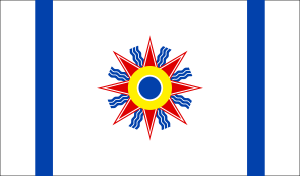Assyrian Australians
Assyrian Australians are Australians of Assyrian descent or Assyrians who have Australian citizenship. According to the census, 40,218 persons are Assyrian, 21,166 identified themselves as having Chaldean ancestry.[2] Historically, Assyrian people were indigenous to their ancient ancestral Assyrian homeland that corresponds to modern-day northern Iraq, southeast Turkey northwestern fringes of Iran and, much recently, northeast Syria.[3] The majority of Assyrian Australians have immigrated mainly from Iraq, Iran, Syria, Jordan and the Caucasus.
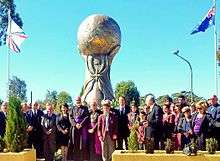 Assyrians standing next to the genocide monument in Western Sydney. | |
| Total population | |
|---|---|
| 61,418 (by ancestry, 2020)[1] | |
| Regions with significant populations | |
| Sydney Melbourne | |
| Languages | |
| Neo-Aramaic, Arabic, Persian, English | |
| Religion | |
| Mainly Christianity (majority: Syriac Christianity; minority: Protestantism) | |
| Related ethnic groups | |
| Assyrian Americans, British Assyrians, Assyrian Canadians |
Of the 61,418 Assyrians in Australia, 40,218 are members of the Assyrian Church of the East or Ancient Church of the East and 21,172 are members of the Chaldean Catholic Church. The City of Fairfield, in Sydney, has the most Assyrians in Australia, with 75% of Assyrians living in that area. 95% of Fairfield's Iraqi-born population are of Assyrian ancestry. Fairfield LGA also has one of the most predominant Assyrian communities in the diaspora, where one in every ten person would be Assyrian. Moreover, in contrast to other migrants, Assyrians have the highest rate of acquiring the Australian citizenship.[4]
During the 1980s war between Iraq and Iran, large numbers of Assyrians fled Iraq and applied for refugee status. In the early 2000s, 5% of Australia's humanitarian immigrants identified as being adherents of Syriac churches. In May 2013, the Assyrian genocide was recognised by the New South Wales state parliament.[5][6] Assyrian-Australians have established various clubs, social organisation, churches and language schools. Representing only 0.13% of Australia's overall population, Assyrians are considered to be a successful minority group.[7]
History
Early immigration (1950s–1970s)
The first Assyrians arrived in Australia in the 1950s, to flee from the 1958 revolution in Iraq. By 1965, there were around five Assyrian families and a few individuals living in the Sydney suburbs of Randwick. Although around 80% of the arrivals lived in the suburbs of Fairfield LGA in Greater Western Sydney, some Assyrians settled in the eastern suburbs, a region on Sydney's coast. During that period 4,500 Assyrians came from Iraq, 2,500 from Iran and 1,000 from Syria and Lebanon. According to Dinkha Warda, Fairfield was the most popular settlement among Assyrians for reason as follows:[8]
Back in 1966, a small meeting was held between the early settlers to decide the future of Assyrians in this country...In 1966, Fairfield's developed area went west up to the Cumberland Highway. The majority of those attending the meeting agreed to establish the Assyrian community in Fairfield. The reason was to centralise the development of all the Assyrian social, religious and sporting activities, allowing greater access and participation. If we remained in the Sydney city area, we would have scattered. And so, four or five families purchased fibro houses in Fairfield (including myself), and a few bought blocks of land.
In 1969, following the settlement of Assyrians in the Fairfield area, the Assyrian Australian Association (AAA) was formed. In the 1970s, a few soccer clubs were established as the Assyrian community began to have a prominence. An Assyrian language school was formed in 1974, thanks to the AAA.[9]
Community growth (1980s–2000s)

In 1980, Nineveh Club, a prominent Assyrian club in Edensor Park, Sydney, was established. Built with artificial mud brick, the Club was designed after Assyrian royal palace in Nineveh. The entryway features two winged bull statues containing the body of a lion, the head of an Assyrian king and wings of an eagle. In the late 1980s, the The Church of the East was controversially split – The Church of the East in Australia from that time on now has two denominations; The 'old' (Ancient Church of the East) and the 'new' (Assyrian Church of the East).

As the Assyrian community grew in the late 1980s, the Assyrian Sports and Cultural Club was subsequently opened in 1990, in Fairfield Heights, Sydney. The club acquired liquor and gaming licenses. The club co-hosted sports events such as The Assyrian Cup soccer tournaments and held functions and activities for the community. It has also supported migrants, who arrived in the 1990s, settle in the country and it encouraged education by aiding achievers in the high school certificate. During the late 1990s, there was an increased level of Assyrian migration to Australia under the family reunion, refugee and humanitarian programs. Reportedly, around 903 Assyrian arrivals were allowed under the Australian Government's Special Humanitarian Program and the Family Reunion Program.[10]
In 1997, it was reported that, for the Assyrian youth, lack of English skills was the major impediment for gaining employment, school achievement and becoming socially manoeuvrable in the Australian society. For instance, some Fairfield High School Assyrians wanted to go to university but felt hopeless because of their poor English. As such, several Assyrian churches developed a number of youth programs. For Assyrians with a higher education, the problem was also language and unacceptability of overseas qualifications, which prevented them from pursuing their careers.[11]
The opening of St Hurmiz Primary School in 2002, in Sydney, was the first school from the ACOE that was established in the international diaspora. In 2006, also in Sydney, St. Narsai Assyrian Christian College was established. It was the first ACOE high school to be built in the western world.
Post-Iraqi war (2010s–present)

On August 2010, a memorial monument for the Assyrian genocide was erected in Bonnyrigg. The statue, being 4.5 meters tall, is designed as a hand of a martyr draped in an Assyrian flag. The memorial is placed in a reserve to be named the Garden of Nineveh. The statue and the name for the reserve were proposed in August 2009. After consultation with the community, Fairfield Council received more than 100 submissions, including some from overseas, and two petitions. The proposal was condemned by the Turkish community. Turkey's consul general to Sydney expressed resentment about the monument, while acknowledging that tragedies had occurred to Assyrians in the period as well as Turks.[12]
On August 2014, more than 6,000 Assyrians marched in Belmore Park in Sydney CBD to protest against the treatment of their Assyrian counterparts in Iraq and Syria by ISIL. Many wore T-shirts reading the hashtag #WeAreN, and chanted "we want peace, we want justice" and "save our Christians". They also waved posters, which read "stop genocide against our Christians" and "Stop crimes against humanity". They marched in Elizabeth Street, through the city to Martin Place. Assyrian Community leaders made passionate speeches soliciting the Australian and other international governments to help those being persecuted in the Middle East.[13]
In 2015, the Abbott government announced that 12,000 extra humanitarian visas would be given to persecuted groups in the war-torn Middle Eastern countries. The Department of Social Services confirmed that 11,400 Iraqi and Syrian refugees (many of whom being Assyrian) were admitted to Australia as part of its one-off humanitarian intake, where they would primarily settle in Fairfield and Liverpool. The Assyrians told SBS World News they were in an unswerving state of despair, as they hoped more and more of their kin from the Middle East were brought to the country. Carmen Lazar, manager of the Assyrian Resource Centre, said, "If they can just lend another hand, you know, give us another 12,000 intake, just to release that pressure from what's happening overseas".[14]
Demographics
Distribution
Sydney



In Sydney, Assyrians are the leading ethnic group in the Fairfield LGA suburbs of Fairfield, Fairfield Heights and Greenfield Park. Ample amount of Assyrians exist in other suburbs in the Fairfield LGA, such as, Bossley Park, Prairiewood, Wakeley, Wetherill Park, Abbotsbury, Smithfield, Fairfield West, Bonnyrigg Heights, Horsley Park and Cecil Park.[16]
In City of Liverpool, a LGA that borders Fairfield City, they're found in Cecil Hills, Green Valley, Hoxton Park, Hinchinbrook and Middleton Grange. In the southern and eastern suburbs, they're mainly found in Hillsdale, Matraville, as well as Maroubra.
Sydney's local government areas with the most Assyrians, population and percentage-wise:[17]
Greater Fairfield is home to over 20,000 Assyrians.
- Fairfield City: 13,437 (5.7%)[18]
- Liverpool City: 2,451 (1.3%)
- Bayside Council: 635 (1.22%)
- Blacktown City: 459 (0.15%)
- Canterbury-Bankstown: 202 (0.11%)
Melbourne
In Melbourne, Assyrians tend to be found in the northwest region, in the suburbs of Broadmeadows, Craigieburn, Meadow Heights, Roxburgh Park and Fawkner. According to the 2016 census, Melbourne had around 13,000 citizens who claimed Assyrian ancestry.[19]
The population of Assyrians in the suburbs of Melbourne (2016 census):
- Roxburgh Park – 3,281
- Craigieburn – 2,573
- Meadow Heights – 1,334
- Greenvale – 571
- Coolaroo – 337
- Gladstone Park, Victoria – 199
Brisbane
In Brisbane, small Assyrian (and Iraqi Christian)[20] communities are slowly growing around the Moreton Bay area such as Bracken Ridge and Strathpine including in Logan City such as Woodridge and Loganlea due to the recent Syrian and Iraqi refugees coming into Australia.
According to the 2016 census, they are 311 Assyrians living in Brisbane which has almost doubled from the 2011 census.[21] 407 Iraqis according to the 2016 census in Brisbane identified as Christian.
General statistics
In the 1996 census, there were 9571 people who spoke Assyrian in the state of NSW, and 2191 in Victoria. 60% of these Assyrians were born in Iraq, 21% in Australia and 13% in Iran. Also in that time, 54% belong to the Assyrian Church of the East, 27% belonged to the Chaldean Catholic Church and 7% to the Orthodox church. In the 2001 census, 9,520 Fairfield LGA residents stated they were of Assyrian ancestry and 8,879 residents stated they spoke Assyrian at home. The Assyrian-speakers living in NSW were 13,241 at that time. In the 2011 Census, Sydney had 21,678 people of Assyrian descent,[22] and Melbourne had 8,057.[23] Assyrians are the third largest language-group residing in the Fairfield area behind the Arabic and Vietnamese-speakers, respectively.[24]
According to the 2001 census, 29% of Assyrian migrants in Fairfield were usually made up of large families with five members or more. 13–24-year olds made up 18% of the migrating population and 25–54 years were at 57%. 25% of them did not speak English well. 43% of the Assyrians in the Fairfield LGA owned their home, and they generally worked in manufacturing (39%), trade, accommodation, hospitality and transport industries (31%).[25]
Whilst the new arrivals are settling in Fairfield CBD and Fairfield Heights, the pre-mid-1990s arrivals have purchased and/or rented houses in the more affluent suburbs of Fairfield City, such as, Bossley Park, Wetherill Park and Greenfield Park, which are around 6 kilometres (3.7 mi) west from Fairfield CBD. Furthermore, some of the recently arrived Assyrian children have had psychological trauma for the experiences in their countries of origin, which encroached their settlement in Australia.[26]
Culture
.jpg)
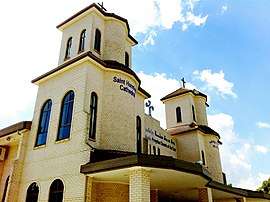
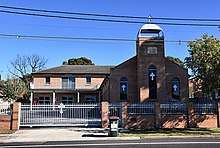
Sydney has seven prominent Assyrian church buildings; St Mary's Church in Smithfield (established in 1975), St Thomas Church in Bossley Park, St Mary's Assumption Churchin Fairfield, St Hurmiz Cathedral in Greenfield Park, St Malkeh Church in Greenacre, and St Zaia Cathedral in Middleton Grange.
In Melbourne, the churches are Our Lady Guardian of Plants Chaldean Catholic Church in Campbellfield, Victoria, St. George’s Church of the East in Reservoir, Victoria.[27] , ‘’Holy Spirit Syriac Catholic Church’’ in Dallas and ‘’ St Aphrem Syrian Orthodox Church’’ which also is in Reservoir, Victoria.
Assyrians, depending on the village/town they belong to commemorate their specific patron saints and celebrate it usually with their famillies at picnics or halls. For example, the Assyrians from the Batnaya town commemorate Mar Oraha. The feast of Mar Oraha is partaken in an annual prayer and celebration. Celebrations include traditional Assyrian dancing with Assyrian singers, food and people wearing traditional Assyrian clothing from Batnaya.
Assyrians from Alqosh commemorate Mar Mikha, who was one of the holy fathers of Alqosh. Alqoshnaye celebrate the Feast of Mar Mikha, known as 'Shara'd Mar Mikha' around the world. This event is celebrated through picnics or halls, like many other Shereh (Feasts). The 'St. Hirmized' group is an Alqosh association of Sydney which organises events which relate to their town. People from Alqosh, like many other Assyrian towns/villages wear their traditional clothing at these events which commemorate their patron saints and celebrate the history of their towns.
Some ACOE adherents in Sydney annually commemorate Saint Zaia (Shara 'D Mar Zaia) at Blaxland Crossing Reserve in the suburb of Wallacia on September. Hundreds attend the occasion, including Assyrian singers who perform for the event. Visitors would generally picnic, barbecue or relax in the Australian bush, and they would usually participate in Assyrian folk dance. This is the second largest Assyrian social gathering in Sydney after the New Year celebration in Fairfield Showground.[28]
Both Nineveh Club and Assyrian Sports and Cultural Club support and showcase local Assyrian talents, such as singers, actors, musicians, painters and sculptors. The clubs contain reception halls and they usually host singer concerts (including lounge singers), festive parties, weddings, theatrical plays and other forms of social entertainment for the Assyrians in Sydney.[29]
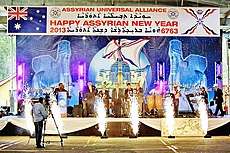
The Assyrians in Sydney lavishly celebrate the Assyrian New Year annually on 1 April, in Fairfield Showground in Prairiewood. Thousands attend the New Year festival and it usually features music and theatrical performances, traditional dancers, food stalls and fireworks.[30] Former Australian prime minister Tony Abbott[31] and other politicians such as Chris Bowen, Craig Kelly, Tanya Plibersek, Chris Hayes and former NSW premier Bob Carr have attended the festival and made a speech.[32]
Fairfield's large Assyrian community has had the media describe the suburb as 'Little Iraq' or 'Little Assyria'. Assyrian businesses have opened in Fairfield, mostly in Ware Street and Smart Street, and in Fairfield Heights in The Boulevarde. These businesses include everything from jewellery shops to restaurants and convenient stores, making the area favourite entertainment and shopping hot spot for the Assyrian community.[33]
Church split controversy
In 1987, there was a major church split in the Church of the East in Fairfield, which shook and divided the community. The notorious event resulted in legal proceedings over property rights and it even received national media coverage. After the Supreme Court of New South Wales ruled in favour of bishop Mar Meelis Zaia, the Assyrian Church of the East diocese of Australia and New Zealand, to take ownership of St Mary's Church, Assyrians of the Ancient Church of the East sect protested since they found the court's ruling highly objectionable and unjust, as their sect claimed the St Mary's Church beforehand. A few of them eventually got involved in a frantic brawl outside the courthouse with those part of the Assyrian Church of the East sect.
Richard Carleton from 60 minutes covered the story in a studio that contained around 200 Assyrians who opposed the Bishop. Carleton belligerently faced the few men who were involved in the brawl and asked if they were apologetic about their actions, which the men stated they were merely acting in "self-defense" and "fighting for their rights" (as the court neglected their perspective). The Bishop described the actions of his raucous opponents as "primitive". Author and journalist David Leser criticised the 60 Minutes portrayal of Assyrians in his book The Whites of Their Eyes, saying, "12 minutes of prime-time baiting of a community that had been law-abiding and peaceful prior to and subsequent to that event. There was no one millisecond devoted to explaining the intricacies of the dispute".[34]
Sport
Assyrian Australians, like many other Assyrians from around the world, are mainly fond of soccer, and have established various football clubs in Australia. Fairfield Bulls Soccer Club, based in Sydney, is the most prominent soccer club in the country. It was established in 1971 and it has involved hundreds of children and teenagers in different age teams. Legislated by Football NSW, Fairfield Bulls became a standalone club in 2005. The Soccer Club was linked with Nineveh Sports and Community Club. Another conspicuous Assyrian soccer club in Sydney, established in the early 1970s, is the Nineveh Eagles.[35] In Melbourne, two Assyrian soccer teams exist, being; Moreland United FC and Upfield FC. Many Assyrian people cheer for their teams, local and international. The teams include the Assyriska FF, as well as the Iraqi and Syrian national teams. Sydney's Assyrian community assembled in Fairfield to celebrate Iraq qualifying for the Asian Football Cup finals in 2007. More than 7000 people, including Iraqi Arabs, joined in street celebrations around Fairfield on Sunday 29 July 2007 after Iraq won the Asian Cup finals.[36]
Media
Most Assyrian-Australian media is aired on the radio. Assyrian radio has a variety of themes and topics which consist mainly of Assyrian music and interviews with prominent Assyrian individuals, and politics, current events, weather, sport and history. These subjects are usually affiliated with Assyrian people, their culture and homeland. In the late 90s through to 2004, channel 31, a community channel, broadcast in Assyrian one to three hours a week.
Radio
- SBS Radio, which airs in Sydney and Melbourne, broadcasts in the Assyrian language every Saturday and Tuesday evenings from 8 pm to 9 pm.[37]
- 2000FM, a Sydney radio station, airs in the Assyrian language every Monday mornings for three hours, on the frequency of 98.5 FM.[38]
- 2GLF, a community radio station in Sydney's suburb of Liverpool, on the frequency of 89.3 FM, broadcasts a number of Assyrian shows. Nohadra Radio, established in 1998, is the most prominent Assyrian radio show on the station, which airs Sunday nights from 8 pm to 10 pm.[39]
Assyrian Australians
- Emil Shimoun Nona – Current Bishop of the Chaldean Catholic Church in Australia & New Zealand.
- Sham Khamis – Plays for Canberra United FC in the Australian W-League.[40]
- Ninos Khoshaba – Politician and is a former member of Parliament of New South Wales.
- Cindy Sargon – TV chef and business woman.
- Meelis Zaia – Assyrian Church of the East's metropolitan bishop of Australia, New Zealand and Lebanon.
- Andrew Rohan – A politician, who was a member of the New South Wales Legislative Assembly representing Smithfield for the Liberal Party of Australia from 2011 to 2015.[41]
- Leena Khamis – Plays for Sydney FC in the Australian W-League and the Matildas.[42]
- Mario Shabow – Plays for Central Coast Mariners FC in the A-League.[43]
- Sue Ismiel – Founder and owner of Nad's.
- Michael Denkha - Actor known for films such as The Combination and popular Australian TV show Here Come the Habibs
- Anwar Khoshaba – Former Mayor of Fairfield.
- Robin Zirwanda – Singer most known from his Assyrian Latin dance band Azadoota
- Ashur Shimon - Australian comedian, TV personality and lead role on Fat Pizza
See also
References
- "CULTURAL DIVERSITY IN AUSTRALIA, 2016". Australian Bureau of Statistics. 27 June 2017. Archived from the original on 9 July 2017. Retrieved 27 June 2017.
- Kinarah: Chaldeans are not Assyrian but their own ethnicity and people.Twentieth Anniversary of Assyrian Australian Association 1989, Assyrian Australian Association, Edensor Park.
- Reforging a Forgotten History: Iraq and the Assyrians in the Twentieth Century By Sargon Donabed
- Community Relations Commission For a Multicultural NSW 2004, Cultural Harmony. The Next Decade 2002–2012 (White Paper), New South Wales Government, Sydney South.
- "NSW Parliament formally recognises Assyrian genocide as Smithfield MP Andrew Rohan shares tale of parents' survival". The Daily Telegraph. 14 May 2013. Retrieved 17 March 2015.
- "Assyrian Genocide Monument Unveiled in Australia". Assyrian International News Agency. 8 July 2010. Archived from the original on 2 September 2010. Retrieved 31 August 2010.
- Winter, I. 2000, Towards a theorized understanding of family life and social capital, Working paper No. 21, April, Australian Institute of family Studies, Melbourne
- Assyrian Australian Association & Ettinger House 1997, Settlement Issues of the Assyrian Community, AAA, Sydney.
- James Jupp (October 2001). The Australian People: An Encyclopedia of the Nation, Its People and Their Origins. Cambridge University Press. pp. 175–. ISBN 978-0-521-80789-0.
- 2004, Australia's Support for Humanitarian Entrants 2003–04, Commonwealth of Australia, Canberra.
- "Fairfield's Assyrian Resource Centre has secured $40,000 to fund its renovations". The Daily Telegraph. Retrieved 31 January 2014.
- "Turkey protests Assyrian 'genocide' monument". Today's Zaman. Retrieved 26 February 2015.
- Barker, Anne (3 August 2014). "Australian Iraqi Christians stage protest against religious persecution in their homeland by ISIS". ABC News. Retrieved 25 July 2016.
- Dabbagh, Omar (15 May 2017). "Assyrian Australians plead for second special refugee settlement deal". Retrieved 22 June 2017.
- Rubin, M. 2003, 'Are Kurds a pariah minority?', Social Research, vol. 70, no. 1, pp. 295–32
- Deniz, F. 2000, 'Maintenance and Transformation of Ethnic Identity: the Assyrian Case’, The Assyrian Australian Academic Journal
- Greater Sydney – Ancestry
- 2016 Census QuickStats – Fairfield City
- Stone, W. 2001, Measuring Social Capital: Towards a theoretically informed measurement framework for researching social capital in family and community life, Research Paper No. 24, February, Australian Institute of Family Studies, Melbourne.
- http://catholicleader.com.au/news/iraqi-christians-living-in-brisbane-who-made-a-mass-exodus-from-qaraqosh-rejoice-at-liberation-of-their-region
- Assyrians in Sydney
- Assyrians in Melbourne
- Fairfield City Council 2003, State of the Community Report, Fairfield City Council, Wakeley.
- Department of Immigration, Multicultural and Indigenous Affairs 2003, Report of the Review of Settlement Services for Migrants and Humanitarian Entrants, Commonwealth of Australia, Canberra.
- Newton, K. 1997, 'Social capital and democracy', American Behavioural Scientist, vol. 40, no. 5, pp. 575–86
- —1993, Assyrians in Australia, AAA, Sydney
- Zinda Magazine
- Gorgees, P. 2003, 'The Assyrian Community's Continued Needs in the Fairfield LGA', in Checking the Pulse of Fairfield―Conference Report, Fairfield Migrant Resource Centre, Cabramatta.
- Rizk, Rita (29 March 2016). "Thousands to attend Assyrian New Year festivities in Fairfield". The Daily Telegraph. Retrieved 25 July 2016.
- McMah, Lauren. "Thousands of people celebrate Assyrian New Year at Fairfield Showground". The Daily Telegraph. Retrieved 25 July 2016.
- "CELEBRATING THE ASSYRIAN NEW YEAR FESTIVAL 6766 IN SYDNEY". Assyrian Universal Alliance. Retrieved 25 July 2016.
- "World on a plate". The Sydney Morning Herald. 13 November 2007.
- The Whites of Their Eyes: Profiles by David Leser, published by Allen & Unwin, 1999
- Stewart Weeks, M. and Richardson, C. 1998, Social Capital Stories, Centre for Independent Studies, Sydney.
- Giorgas, D. 2000, 'Community Formation and Social Capital in Australia', paper delivered to the 7th Australian Institute of Family Studies Conference, Darling Harbour, Sydney, 25 July.
- "Ethnic radio takes to the air". The Sydney Morning Herald. 10 June 1975.
- "The phenomenon known as 2000FM". 2000FM. 2008. Archived from the original on 19 July 2008. Retrieved 28 July 2016.
- "Liverpool Council on 2GLF". Liverpool City Council. 21 June 2006. Archived from the original on 23 July 2008. Retrieved 28 July 2016.
- "Sham Khamis". Archived from the original on 21 December 2016. Retrieved 10 December 2016.
- Green, Antony (4 April 2011). "Smithfield". NSW Votes 2011. Australian Broadcasting Corporation. Retrieved 29 July 2016.
- "Leena Khamis". Archived from the original on 20 December 2016. Retrieved 10 December 2016.
- "Mario Shabow". Archived from the original on 8 December 2015.
External links
- Assyrian Churches in Australia
- Nohadra Radio
- St. Narsai Assyrian College
- St Hurmizd Assyrian Primary School
- AshurSat
- Fairfield Bulls Soccer Club
- Tony Abbott – Prime Minister of Australia speaks at Assyrian New Year 2015
- Assyrian Radio Schedule, 2GLF
- St Thomas The Apostle Chaldean and Assyrian Catholic Diocese of Australia and New Zealand
- St Zaia Cathedral, Sydney


